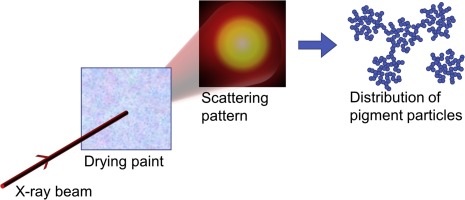当前位置:
X-MOL 学术
›
Prog. Org. Coat.
›
论文详情
Our official English website, www.x-mol.net, welcomes your
feedback! (Note: you will need to create a separate account there.)
Dispersion state of TiO2 pigment particles studied by ultra-small-angle X-ray scattering revealing dependence on dispersant but limited change during drying of paint coating
Progress in Organic Coatings ( IF 6.5 ) Pub Date : 2020-05-01 , DOI: 10.1016/j.porgcoat.2020.105590 David Löf , Guillaume Hamieau , Michael Zalich , Pascal Ducher , Søren Kynde , Søren R. Midtgaard , Claire F. Parasida , Lise Arleth , Grethe V. Jensen
Progress in Organic Coatings ( IF 6.5 ) Pub Date : 2020-05-01 , DOI: 10.1016/j.porgcoat.2020.105590 David Löf , Guillaume Hamieau , Michael Zalich , Pascal Ducher , Søren Kynde , Søren R. Midtgaard , Claire F. Parasida , Lise Arleth , Grethe V. Jensen

|
Abstract The dispersion state of titania (TiO2) pigment particles in coatings is crucial to obtain optimal optical properties while minimizing the consumption of pigment, and thereby the cost and environmental impact of the product. By having the particles well-dispersed, with limited aggregation, the best opacity can be obtained with the smallest amount of pigment. The aggregation of titania particles is typically investigated using various microscopy techniques on the dry coating. In this work, Small-Angle X-ray Scattering was applied as a non-invasive tool to probe the distribution of titania during the coating drying process. The titania pigment particles were dispersed by using either a polymeric surfactant or nanosized silica particles as dispersant. The use of silica nanoparticles resulted in the highest degree of dispersion, both in dilute suspension, and in acrylic and alkyd-based coating formulations. Only minor changes in the aggregate structure was observed during drying of the coatings, indicating that the optical performance is to a large extent determined already before drying, in the wet paint. For the formulations containing nanosilica dispersant, the drying time was increased by diluting the paint or by adding less dryer catalyst. The former resulted in a reduced pigment dispersion, whereas the latter seems to increase the degree of dispersion. In both cases, however, the change of dispersion during the drying phase remained minor.
中文翻译:

通过超小角 X 射线散射研究 TiO2 颜料颗粒的分散状态,揭示了对分散剂的依赖性,但在油漆涂层干燥过程中变化有限
摘要 涂料中二氧化钛 (TiO2) 颜料颗粒的分散状态对于获得最佳光学性能同时最大限度地减少颜料消耗至关重要,从而降低产品的成本和环境影响。通过使颗粒分散良好,聚集有限,可以用最少的颜料获得最佳的不透明度。通常使用各种显微镜技术在干涂层上研究二氧化钛颗粒的聚集。在这项工作中,小角度 X 射线散射被用作一种非侵入性工具来探测涂层干燥过程中二氧化钛的分布。通过使用聚合物表面活性剂或纳米尺寸的二氧化硅颗粒作为分散剂来分散二氧化钛颜料颗粒。二氧化硅纳米粒子的使用导致最高程度的分散,无论是在稀释悬浮液中,还是在丙烯酸和醇酸基涂料配方中。在涂层干燥期间仅观察到聚集体结构的微小变化,这表明光学性能在很大程度上在干燥之前已经在湿涂料中确定。对于含有纳米二氧化硅分散剂的配方,通过稀释油漆或加入较少的干燥催化剂来增加干燥时间。前者导致颜料分散减少,而后者似乎增加了分散程度。然而,在这两种情况下,干燥阶段分散体的变化仍然很小。表明光学性能在很大程度上已经在干燥之前确定,在湿涂料中。对于含有纳米二氧化硅分散剂的配方,通过稀释油漆或加入较少的干燥催化剂来增加干燥时间。前者导致颜料分散减少,而后者似乎增加了分散程度。然而,在这两种情况下,干燥阶段分散体的变化仍然很小。表明光学性能在很大程度上已经在干燥之前确定,在湿涂料中。对于含有纳米二氧化硅分散剂的配方,通过稀释油漆或加入较少的干燥催化剂来增加干燥时间。前者导致颜料分散减少,而后者似乎增加了分散程度。然而,在这两种情况下,干燥阶段分散体的变化仍然很小。
更新日期:2020-05-01
中文翻译:

通过超小角 X 射线散射研究 TiO2 颜料颗粒的分散状态,揭示了对分散剂的依赖性,但在油漆涂层干燥过程中变化有限
摘要 涂料中二氧化钛 (TiO2) 颜料颗粒的分散状态对于获得最佳光学性能同时最大限度地减少颜料消耗至关重要,从而降低产品的成本和环境影响。通过使颗粒分散良好,聚集有限,可以用最少的颜料获得最佳的不透明度。通常使用各种显微镜技术在干涂层上研究二氧化钛颗粒的聚集。在这项工作中,小角度 X 射线散射被用作一种非侵入性工具来探测涂层干燥过程中二氧化钛的分布。通过使用聚合物表面活性剂或纳米尺寸的二氧化硅颗粒作为分散剂来分散二氧化钛颜料颗粒。二氧化硅纳米粒子的使用导致最高程度的分散,无论是在稀释悬浮液中,还是在丙烯酸和醇酸基涂料配方中。在涂层干燥期间仅观察到聚集体结构的微小变化,这表明光学性能在很大程度上在干燥之前已经在湿涂料中确定。对于含有纳米二氧化硅分散剂的配方,通过稀释油漆或加入较少的干燥催化剂来增加干燥时间。前者导致颜料分散减少,而后者似乎增加了分散程度。然而,在这两种情况下,干燥阶段分散体的变化仍然很小。表明光学性能在很大程度上已经在干燥之前确定,在湿涂料中。对于含有纳米二氧化硅分散剂的配方,通过稀释油漆或加入较少的干燥催化剂来增加干燥时间。前者导致颜料分散减少,而后者似乎增加了分散程度。然而,在这两种情况下,干燥阶段分散体的变化仍然很小。表明光学性能在很大程度上已经在干燥之前确定,在湿涂料中。对于含有纳米二氧化硅分散剂的配方,通过稀释油漆或加入较少的干燥催化剂来增加干燥时间。前者导致颜料分散减少,而后者似乎增加了分散程度。然而,在这两种情况下,干燥阶段分散体的变化仍然很小。











































 京公网安备 11010802027423号
京公网安备 11010802027423号